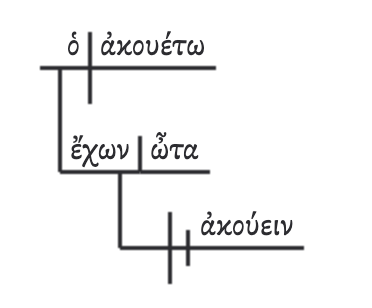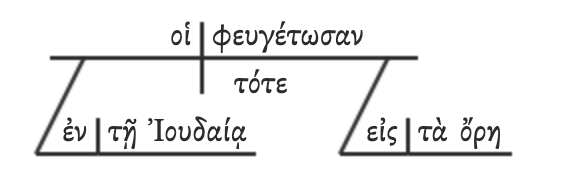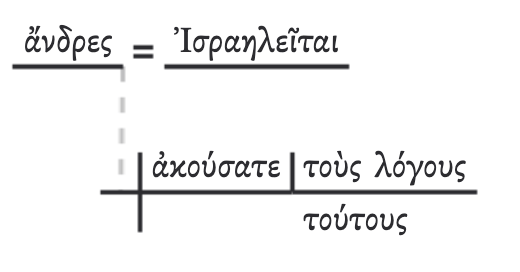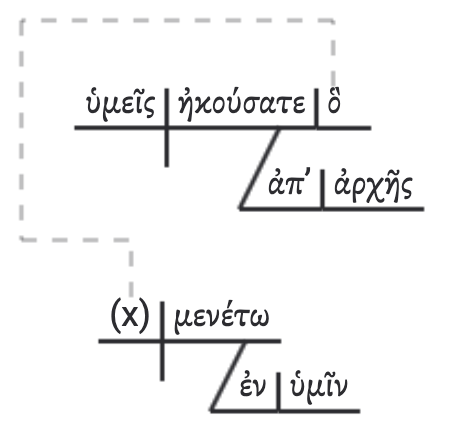Lesson 4 | Imperatives
[3] Common Uses
Verbal Aspect
In the imperative mood, verbal tense communicates aspect only, without reference to time. The perfective aspect looks at the action of the verb as a whole, and so an aorist imperative is the most basic way to express a command.¹ A present imperative (imperfective aspect) may add a sense of continuing action. I say “may add” because the difference between the imperfective and perfective aspect can be subtle in imperatives. The lexical meaning of the word and the context will have much to do with which tense an author or speaker uses.
λέγει αὐτοῖς, λάβετε Πνεῦμα Ἅγιον He said to them, “Receive the Holy Spirit.” —John 20:22
The perfective aspect fits this context, where the action of receiving the Holy Spirit is viewed as a complete whole.
μὴ λαμβάνετε αὐτὸν εἰς οἰκίαν Do not receive him into your house —2 John 1:10
In this case, John is warning believers not to receive false teachers into their homes. The imperfective aspect reflects the ongoing nature of the command. In some cases it may be appropriate to translate present imperatives with the word “continue.” Since this is a negative command, adding “continue” makes it sound as though they were already receiving false teachers and needed to stop doing so! “Do not continue receiving him into your house.” Though we cannot rule out this possibility, it is not likely to be the case in this context. (See “Prohibitions” below.)
Command
The most basic (and most common) use of the imperative is as a simple command. When the apostle Paul faced opposition to his preaching in Corinth, the Lord appeared to him in a vision and said,
μὴ φοβοῦ, ἀλλὰ λάλει “Do not be afraid, but go on speaking...” —Acts 18:9
Request
When the speaker is addressing someone with greater authority, the force of an imperative is softened from a command to a request. For example, the disciples asked Jesus,
εἰπὸν ἡμῖν πότε ταῦτα ἔσται; “Tell us, when will these things be?” —Mark 13:4
Prohibitions
A prohibition is simply a negative command. Prohibitions in the present tense use the imperative mood, while aorist prohibitions often occur in the subjunctive mood. Let’s revisit the Lord’s message to Paul in Acts 18. We did not include the whole sentence above.
μὴ φοβοῦ, ἀλλὰ λάλει καὶ μὴ σιωπήσῃς “Do not be afraid, but go on speaking and do not be silent.” —Acts 18:9
There are two prohibitions here:
- μὴ φοβοῦ is a present imperative. Notice that the imperative verb is negated with μή. This can be a helpful clue when you are uncertain if a second person plural form is an indicative or an imperative. Indicatives are typically negated by οὐ, while non-indicatives verbs use μή. Notice also that the context may warrant that we understand the imperfective aspect here to mean “do not continue to be afraid.”
- μὴ σιωπήσῃς is an aorist subjunctive. In such cases, you should translate the subjunctive mood the same as you would an imperative.
Third Person Imperatives
A speaker might use a third person imperative to command persons within a group without addressing a particular individual. We can translate this by adding the words “Let him…” For example, Jesus often concluded a parable with the exhortation,
ὁ ἔχων ὦτα ἀκούειν, ἀκουέτω He who has ears to hear, let him hear —Matthew 11:15
Here, the substantival participle ὁ ἔχων (nominative, masculine, singular) is the subject of the third person imperative.

Or a speaker may indirectly command someone other than the person(s) he or she is speaking to.
τότε οἱ ἐν τῇ Ἰουδαίᾳ φευγέτωσαν εἰς τὰ ὄρη Then let those who are in Judea flee to the mountains —Luke 21:21
In this instance, the plural article οἱ turns the prepositional phrase ἐν τῇ Ἰουδαίᾳ into a substantival. The nominative article marks this substantival phrase as the subject of the third person verb.

Finally, the third person may be used to directly address someone, but with reference to a third person subject.
οὕτως λαμψάτω τὸ φῶς ὑμῶν ἔμπροσθεν τῶν ἀνθρώπων Let your light so shine before men —Matthew 5:16
This use can be a little confusing. In English, the subject of the sentence is “you” (“shine your light”). But remember, English only uses second person imperatives. In Greek, the subject of the verb is not the person being commanded but the thing which participates in the action of the verb (a light shines).

In each of these examples, we have used the word “let” to help translate the third person imperative. The potential risk with this translation is that it sounds more like the speaker is merely permitting the action of the verb. So, in your interpretation and teaching, don’t neglect the force of the imperative. If the context warrants, a third person imperative can be translated with the word “must” (e.g. “he must go”).
Examples from the Greek NT
ἐν τῷ ὀνόματι Ἰησοῦ Χριστοῦ τοῦ Ναζωραίου, περιπάτει "In the name of Jesus Christ, the Nazarene, walk!" —Acts 3:6b

Let's consider the verb περιπάτει.
περιπατε+ε
[Stem]
[Tense-Former]
[Ending]
You should recognize the stem from the vocabulary word περιπατέω. Since this stem ends in a vowel, we can expect that a vowel merger has occurred. So now the question becomes, what ending was added that merged to form ει? There are two possibilities: It could be the present, active, indicative, third person, singular ending ει or the present, active, imperative, second person, singular ending ε. The context provides the main clue that this is not an indicative. The translation would be "In the name of Jesus Christ, the Nazarene, he is walking." That would not fit the context at all since Peter is directly addressing the lame man and not merely talking about him. Moreover, the man to whom Peter is talking has never walked a day in his life! (Another clue is that the indicative, third person, singular form is περιπατεῖ. But the difference in accent is not a reliable clue in every case.) So, we can conclude that περιπάτει is the present, active, imperative, second person, singular from περιπατέω. It is a direct command, "Walk!"
ἄνδρες, Ἰσραηλεῖται, ἀκούσατε τοὺς λόγους τούτους "Men, Israelites (or Men of Israel), hear these words..." —Acts 2:22a

Can you parse the verb ἀκούσατε?
ακου+σα+ετε
[Stem]
[Tense-Former]
[Ending]
The first and most important tool in identifying the key features of any verb is being able to recognize the stem. That means keeping up on reviewing all your vocabulary! In this case, you should also quickly recognize the aorist tense former σα, which delineates both the stem and the ending. The ε connecting vowel drops off the ending because the tense former has its own vowel. So you should be able to identify _σατε as an aorist, active, second person, plural. But is ἀκούσατε an indicative or an imperative? An aorist indicative would have an augment ἠκούσατε. So this can only be the aorist, active, imperative, second person, plural from ἀκούω.
ὑμεῖς ὃ ἠκούσατε ἀπ’ ἀρχῆς, ἐν ὑμῖν μενέτω. Let what you heard from the beginning abide in you. —1 John 2:24

Let's examine the verb μενέτω.
μεν+ετω
[Stem]
[Tense-Former]
[Ending]
The ετω ending is uniquely an imperative form. That leaves the stem μεν* from the verb μένω. So this is the present, active, imperative, third person, singular from μένω. As a third person imperative, we should look for a noun or a substantival clause that stands as the subject. The relative pronoun ὃ establishes its own clause, with the nominative subject ὑμεῖς and the aorist indicative verb ἠκούσατε (note the augment, which tells us it must be an indicative). The relative pronoun points forward to the subject of the imperative verb.